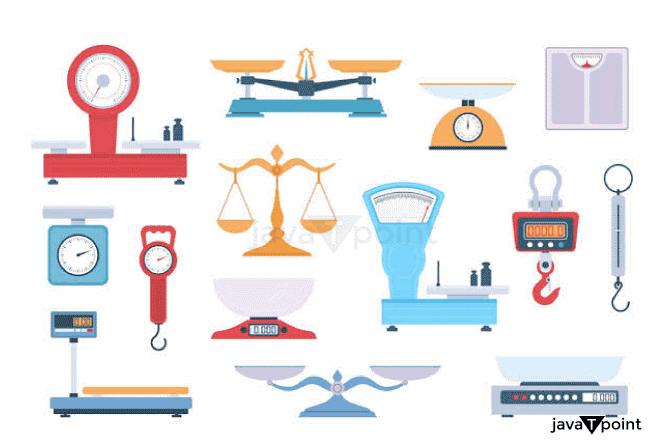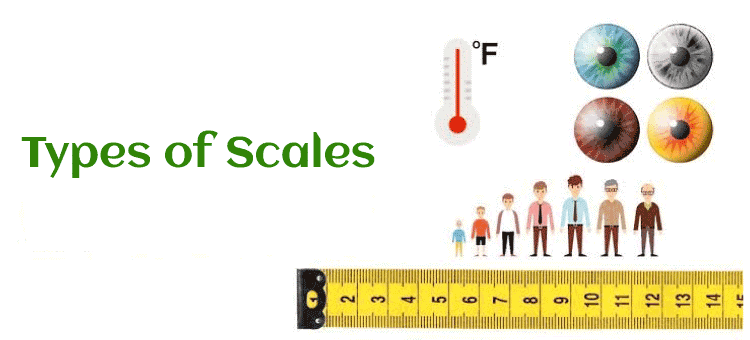Scale DefinitionThe concept of "scale" is a crucial aspect used to define, measure, and analyze numerous events in many fields of study. Depending on the context, the term "scale" can refer to a weight-measuring tool, a measurement system, a sequence of levels or gradations, or the size and scope of an object. 
Scale is the factor by which a quantity is multiplied or divided to change its size in arithmetic. Nominal, ordinal, interval, ratio, Likert, logarithmic, and geometric scales are all utilized in a variety of professions. The scale utilization is dictated by the type of data being assessed as well as the goal of the study. Knowing and utilizing the appropriate scale is essential for accurate and relevant data analysis and interpretation. Many fields including mathematics, engineering, physics, biology, economics, and social sciences use scale as a key concept. It is a useful tool to describe and researching the properties and relationships of various sizes and complexities of things, systems, and measures. Scale in MathematicsIn mathematics, scale is used to indicate the proportions and dimensions of geometric objects and figures. Scale factors are used in maps and blueprints to connect the measurements of objects of different sizes. 
Scale is used in physics and engineering to describe the properties and behavior of materials and systems at various measurements such as in nanotechnology or astrophysics. The concept of scale is significant in mathematics since it is used to measure, compare, and express quantities or values. Here are a few occurrences of scale in mathematics MeasurementA scale is a tool used in mathematics to measure things, distances, and other objects. For instance, the metric system measures length, mass, and volume using units like meters, grams, and liters ProportionsThe comparison of proportions and ratios will be done using a scale. For example, a map's size shows how closely the distance on the map relates to a comparable distance on Earth. In mathematics, ratios and proportions are frequently utilized to solve problems and make predictions. Graphs and ChartsIn mathematics, graphs, and charts are frequently used to visually display data. The scale of the graph or chart determines the range of values that can be displayed as well as the precision of the data. GeometryIn geometry, scale is used to determine the resemblance or congruence of two figures. When two figures are comparable, their sides be proportionate, and a scale factor is a ratio of the lengths of their respective sides. Congruent figures have comparable sides that are the same length and one scale factor. Scale in BiologyScale is used in biology to define the size and arrangement of biological structures such as cells, tissues, organs, and organisms. Ecological systems include individuals, communities, populations, and ecosystems. Knowing the size of biological systems is important to understand how they work and how environmental changes affect them with the usage of scale. Cellular ScaleUnderstanding cell function and structure at the cellular scale is crucial. Cells contain several subcellular structures such as organelles that function at various scales. Knowing how these structures are organized and how they interact is crucial to understanding cellular function. Molecular ScaleScale is important in understanding biological molecules including their molecular interactions. Knowing how molecules interact with one another and how their interactions are modified by the size at which they work is useful for understanding biological processes such as protein folding, enzyme catalysis, and DNA replication. Organismal ScaleBecause the circulatory system acts on an organismal scale, understanding how blood flows through the system is crucial to understanding how the body functions. Ecological ScaleUnderstanding the structure and ecosystem function will be done with the help of an ecological scale. Ecosystems function at many different dimensions, from individual species to enormous biomes, and understanding how these scales interact with one another is dependent on how ecosystems function. Scale in EconomicsScale is used in economics and social sciences to indicate the extent and scope of economic activity such as production, trading, and consumption. 
Scale is also used by social scientists to characterize population size and distribution also the intensity and scope of social events along with the effects of policies and interventions at various sizes. EconomiesThe concept of economies of scale is one of the most significant in economics. This refers to the cost benefits that larger organizations have over smaller enterprises because of their capacity to distribute fixed expenses across a greater output. As it can buy materials in bulk and use specialized machinery. For example, a larger company may be able to produce products more efficiently than a smaller one. Market StructureScale also impacts market structure because larger enterprises frequently control smaller ones. As a result, a small number of massive corporations may hold the bulk of the nation's economic power, which would affect both competition and consumer choice. International TradeScale also has an impact on international trade because larger organizations are frequently better able to compete in global marketplaces due to their size and capacity to take advantage of economies of scale. This can result in a few huge multinational businesses dominating specific industries. Macroeconomic PolicySize is significant in macroeconomic policy since a sector or market size can affect the entire economy's stability and growth. For example, the failure of a huge industry or market might have far-reaching consequences throughout the economy. Scale in GeographyIn geography, Scale refers to the relative size of features on a map or in the actual world. 
Maps are frequently created at various scales, with bigger scales displaying more specific information and smaller scales displaying a broader picture of larger areas. CartographyScale is essential for making accurate maps in cartography. A map's scale defines the ratio between the size of an area on the map and its real size on the ground. Maps of various scales are used for a variety of reasons such as broad local analysis with the use of large-scale maps and regional or global overviews with the use of small-scale maps. Spatial AnalysisScale is crucial in understanding how phenomena are dispersed across space in spatial analysis. Studying geographic data at specific scales can discover patterns and relationships that would not be visible at other scales. For example, analyzing demographic data at the municipal level can reveal distinct patterns than analyzing it at the state level. Human-Environment InteractionScale is crucial in comprehending the impact of human activities on the environment at the human-environment interaction scale. Human activities impacts might vary depending on the scale of analysis where the local impacts are frequently different from global impacts. Regional AnalysisScale is crucial in comprehending the diversity of geographic regions and their interactions at the regional analysis scale. Regional analysis can show regionally distinct patterns of economic, social, and environmental development. Scale in ArchitectureScale is used in architecture and engineering to portray the size of buildings, structures, and systems in drawings and models. Before building begins, architects and engineers can imagine the finished product using scale drawings and models. 
A scale is an important tool in architecture because it influences how structures and distances are pictured, built, and utilized. There are several ways to comprehend the relevance of size in architecture which includes FunctionalityAn essential element in defining a building's functionality is scale. A building's or area's size should be adequate for its intended function. For instance, a room that is too small could seem suffocating and uneasy, whereas a room that is too big might feel frigid and hostile. AestheticsA building's scale significantly affects how aesthetically pleasing it is. A building that is too large or too little in comparison to its surroundings may look out of place and disturb the area's aesthetic balance. SafetyIn terms of safety, scale is also essential. A structure that is too big could make it difficult to evacuate in an emergency, but a building that is too small might not adhere to building codes and safety requirements where the structure can be measured with the help of scale. Scale in PsychologyWhen evaluating psychological constructs including attitudes, emotions, and personality traits, psychologists utilize the Psychology Scale. 
In psychological research, scales such as the Likert scale and the Big Five Personality Traits scale are often utilized. The range and distribution of scores or responses produced from a measure or assessment are stated as scales in psychology. There are numerous approaches to understanding the significance of scale in psychology MeasurementPsychological constructs such as personality characteristics, attitudes, and emotions are assessed using scales. The choice of a suitable scale can have an impact on the precision and validity of the measurements acquired. ComparabilityThe adoption of standardized scales allows results to be compared across research and populations. This promotes the accumulation of knowledge in the field of psychology and allows researchers to reach more robust conclusions based on their results. Clinical diagnosisScales are also used in clinical diagnosis to evaluate the severity of symptoms and to identify mental diseases. The decision of an appropriate scale can affect the accuracy of diagnosis and subsequent treatment. Treatment evaluationScales can be used to assess the efficiency of psychological therapies during treatment. Pre- and post-treatment scales can be used by doctors to find the most effective treatment options by providing an objective measure of treatment outcomes. Research designIn psychology, scales are a crucial component of research design. The choice of an appropriate scale can have an impact on the validity and reliability of the research findings. Scale in MusicIn music, a scale is a group of notes that are organized in ascending or descending order according to a set of principles. Melody and harmony in Western music are built on musical scales. 
There are numerous methods to grasp the impact of scale in music. Scales are significant in music because they give a common language for musicians to interact and produce music together. It additionally provides a sense of structure and order in music, which can make it easier for listeners to follow and appreciate the music. MelodyThe scale is the foundation of melody in music. It serves as a framework for constructing melodies that are attractive to the ear and can elicit a variety of emotions from the listener. HarmonyScales are also utilized in harmony composing. Musicians utilize scales to determine which chords will harmonize with a melody and achieve musical unity. ImprovisationScales are a fundamental component of musical improvisation. Musicians employ scales to develop variations on a melody or chord progression, allowing them to demonstrate their originality and individuality. CompositionScales are commonly used in musical composition. Composers employ scales to structure their works and create a sense of melodic cohesiveness and unity. Cultural significanceDifferent cultures have established their distinct scales which are an important part of their musical legacy. The usage of these scales in music can express cultural identity and connection to the past. Importance of ScaleFollowing are some of the main reasons for the importance of scale Provides a common languageScales provide a common language for describing and measuring events across several fields of study. Researchers and practitioners can effectively convey and compare results across studies by using standardized scales. Allows for precise measurementScales allow for precise measurement of quantities and properties of phenomena. Researchers can establish quantitative comparisons and statistical inferences by giving numerical values to observations. Facilitates accurate analysisKnowing the right scale for a particular event is essential for accurate and relevant data processing and interpretation. Utilizing the improper scale can result in inaccurate findings. Decision-making is made easierKnowing the right scale for a given occurrence is also vital for making knowledgeable judgments in a wide range of applications. For example, Understanding the size of biological processes is essential in environmental management for making appropriate conservation and restoration decisions. Provides a basis for modelingScales serve as a foundation for modeling complicated events and systems. Researchers can construct more accurate and realistic models by understanding the magnitude and organization of the system. Types of ScalesScales are categorized into four types based on how closely scale values resemble true numbers in arithmetic terms. Arithmetic qualities include Order, equal intervals, and a valid zero point. 
The scale types are nominal, ordinal, interval, and ratio in descending order of mathematical difficulty. Arithmetic qualities do not exist for nominal scales whereas the ratio scales possess all three mathematical features. Here are the following types of scales Nominal scalesNominal scales do not measure quantity. Nominal scales divide a population into two or more categories. The categories must be exclusive and exhaustive, it means that every member of the general population must be able to be classified into only one of them. Arithmetic qualities do not exist for nominal scales. There is no bigger or lesser category than another. Only proportionate comparisons of the number of people in each category can be used to make mathematical claims regarding nominal data. Respondent's gender, religious affiliation, political party affiliation, ethnicity, or college major are all examples of nominal scales. Ordinal scalesOrdinal scales "order" members of a population in descending order from most to least, or least to most. The arithmetic property of equal intervals or actual zero points does not apply to rank values. This means that with ordinal data, we only know that one person in a population has more or less of a certain attribute than another, but we will not know how much more or less. We cannot say how much better the best tennis player is than the second-best player, or how much better the third-best player is than the fourth-best player. To determine how much better one rank is than another, identical intervals between rankings must be used to conduct addition and subtraction. Therefore, we cannot claim that the second-best tennis player is twice as excellent as the fourth-greatest tennis player. To conduct multiplication and division, a real zero rank would be required. Ordinal scales can be used to rank beauty pageant winners, athletes, and teams in sports, or respond to preferences for different varieties of ice cream. Interval scalesInterval scales have the property of order as well as equal intervals. On an interval scale, each interval is equal to every other interval on the scale. As a result, for interval data addition and subtraction are valid arithmetic operations. On the other hand, Interval scales, lack a true zero point. As a result, using interval data multiplication and division are invalid. Several interval systems have zero points, such as the centigrade temperature scale, but these are arbitrary zero points. Random zero points do not imply a lack of quality. For example, 0� C does not indicate the absence of heat. Because of the arbitrary definition of 0� C, 8� is not twice as warm as 4�. The absolute zero centigrade temperature is - 276�. In the social sciences, interval scales are rarely utilized. Social psychologists developed a way for creating interval scales for evaluating attitudes in the 1950s. The procedure is time-consuming and based on dubious assumptions. The centigrade and Fahrenheit temperature scales, garment sizes, and the common clock and calendar are all examples of regularly used interval scales in our daily life. Ratio ScalesThe name ratio scales come from the fact that ratios could be calculated using ratio data. However, do not mistake the meaning of ratio with the ratio scale. In other words, a ratio scale has a true zero point and equal-sized gaps between the points. These are not synonymous. All of the arithmetic qualities of interval scales are present in ratio scales, as well as a real zero point. As a result, ratio data can be considered genuine integers, allowing for addition, subtraction, multiplication, and division. Ratio scales are commonly employed in the social sciences and everyday life. Ratio scales include the respondent's annual income, age, height, or weight, and the number of people living in the respondent's family. In addition to weight, other ratio scale examples include height, distance, and time. Ratio scales provide exact quantitative comparisons and calculations, making them useful in many domains including science, engineering, and economics. ConclusionFinally, scale denotes the range and distribution of quantities or measures within a specific domain. It is an important consideration in many fields, including architecture, psychology, and music. The scale of a building or space in architecture influences its utility, beauty, sustainability, safety, and cost. Scales are used in psychology to measure psychological constructs, diagnose mental diseases, assess treatment effects, and plan research studies. Scales are an important aspect of cultural legacy and expression in music because they give a framework for developing melody, harmony, improvisation, and composition. Overall, scale is critical because it gives a framework for understanding, measuring, and developing within a specific area.
Next TopicSkeletal System Definition
|
 For Videos Join Our Youtube Channel: Join Now
For Videos Join Our Youtube Channel: Join Now
Feedback
- Send your Feedback to [email protected]
Help Others, Please Share










